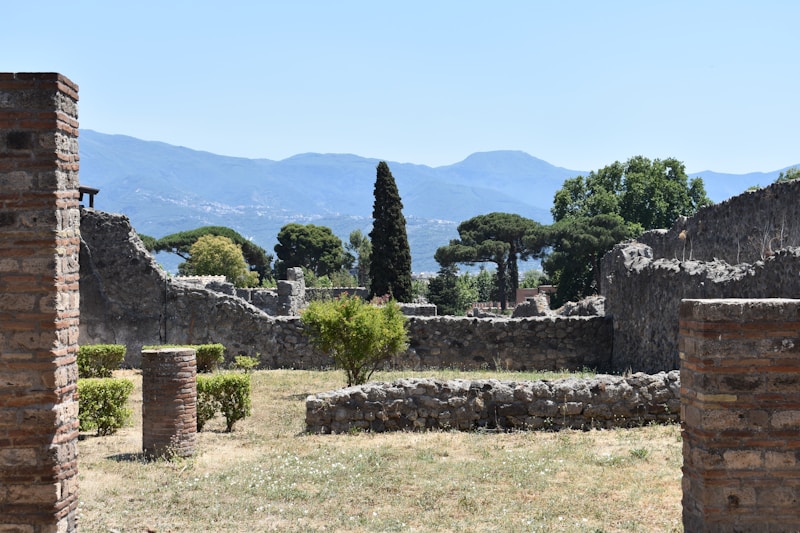9 Questions
What was the population of Pompeii in AD 79?
Around 11,000
What caused the destruction of Pompeii?
A volcanic eruption
Who provided a first-hand account of the eruption of Mount Vesuvius?
Pliny the Younger
When did rediscovery of Pompeii begin?
1592
What is the main concern for the preservation of Pompeii?
Weathering
How much of Pompeii has been excavated?
Two-thirds
What was the main economy of Pompeii based on?
Agriculture
What was the Antiquarium of Pompeii?
A museum
What is the name of the German-Canadian historical disaster film produced and directed by Paul W. S. Anderson about Pompeii?
Pompeii: The Final Hours
Study Notes
Pompeii: An Ancient Roman City near Naples, Italy
-
Pompeii was an ancient city located in what is now the comune of Pompei near Naples in the Campania region of Italy.
-
Pompeii, along with Herculaneum and many villas in the surrounding area, was buried under 4 to 6 m of volcanic ash and pumice in the Eruption of Mount Vesuvius in 79 AD.
-
Pompeii was largely preserved under the ash, offering a unique snapshot of Roman life, frozen at the moment it was buried.
-
Pompeii was a wealthy town, with a population of around 11,000 in AD 79, enjoying many fine public buildings and luxurious private houses with lavish decorations, furnishings, and works of art.
-
Pompeii is a UNESCO World Heritage Site and is one of the most popular tourist attractions in Italy, with approximately 2.5 million visitors annually.
-
The first stable settlements on the site date to the 8th century BC when the Oscans, a population of central Italy, founded five villages in the area.
-
Pompeii entered the orbit of the Hellenic people in Campania from around 740 BC.
-
The Samnites conquered Greek Cumae between 423 and 420 BC and it is likely that all of the surrounding territory, including Pompeii, was already conquered around 424 BC.
-
Pompeii became a Roman colony named Colonia Cornelia Veneria Pompeianorum after it was besieged by Sulla in 89 BC.
-
Pompeii became an important passage for goods that arrived by sea and had to be sent toward Rome or Southern Italy along the nearby Appian Way.
-
In AD 59, there was a serious riot and bloodshed in the amphitheatre between Pompeians and Nucerians which led the Roman Senate to send the Praetorian Guard to restore order and to ban further events for ten years.
-
The inhabitants of Pompeii were affected by a severe earthquake on 5 February 62 and most rebuilding was done in the private sector and older, damaged frescoes were often covered with newer ones.The Story of Pompeii: From Eruption to Rediscovery and Conservation
-
Pompeii was a Roman city located near modern-day Naples, Italy, which was destroyed and buried under a thick layer of ash and pumice following the eruption of Mount Vesuvius in 79 AD.
-
Pyroclastic flows consisting of high-speed, dense, and scorching ash clouds caused instant death to the people of Pompeii and surrounding towns, previously believed to have died by ash suffocation.
-
Pliny the Younger provided a first-hand account of the eruption of Mount Vesuvius, and his uncle, Pliny the Elder, died while attempting to rescue stranded victims.
-
Rediscovery of Pompeii began in 1592, but the city's name and location had been forgotten. It was not until 1763 that an inscription was found, identifying the city as Pompeii.
-
Excavations of Pompeii continued under several directors of archaeology, with progress made in exploration in the 1920s when older layers beneath those of 79 AD were excavated for the first time.
-
Preservation of Pompeii has been a concern due to weathering, erosion, light exposure, water damage, poor methods of excavation and reconstruction, introduced plants and animals, tourism, vandalism, and theft.
-
Two-thirds of the city has been excavated, but the remnants of the city are rapidly deteriorating.
-
Funding is mostly directed into conservation of the site, but due to the expanse of Pompeii and the scale of the problems, this is inadequate in halting the slow decay of the materials.
-
In 2013, UNESCO warned that if restoration and preservation works "fail to deliver substantial progress in the next two years," Pompeii could be placed on the List of World Heritage in Danger.
-
In 2020, many domus gardens, orchards, and vineyards were carefully recreated using depictions in frescoes and archaeological finds to give better insights into what they were like before the catastrophe.
-
The evolution of Pompeii's private and public buildings is often unclear because of the lack of excavations beneath the levels of 79.
-
Pompeii is of great interest for the study of Ancient Roman architecture in terms of building methods and urban planning.
-
Pompeii is a popular tourist attraction, with over 2.5 million visitors in 2019.Life in Pompeii: Public Buildings, Shops and Workshops, Agriculture, Erotic Art, Tourism, Antiquarium of Pompeii, and Popular Culture
-
Pompeii underwent a process of urban development under the Romans, which accelerated in the Augustan period from about 30 BC.
-
Public buildings in Pompeii include the Amphitheatre, two theatres, the Eumachia Building, and at least four public baths.
-
Pompeii had nearly 100 thermopolia (inns or snack-bars that served hot and cold dishes and drinks) and at least 31 bakeries.
-
Wool processing was well developed with 13 workshops that worked the raw material, seven that did the spinning, nine the dyeing, and 18 the washing.
-
Pompeii's economy was based on the production of barley, wheat, millet, wine, and olive oil, for export to other regions.
-
Erotic art was discovered in Pompeii and Herculaneum, causing a clash of cultures between the mores of sexuality in ancient Rome and in Counter-Reformation Europe.
-
Pompeii has been a popular tourist destination for over 250 years, attracting almost 2.6 million visitors per year by 2008.
-
The Antiquarium of Pompeii began as an exhibition venue displaying archaeological finds that represented the daily life of the ancient city.
-
Pompeii was the setting for the British comedy television series Up Pompeii! and the movie of the series.
-
Pink Floyd filmed a 1971 live concert, Pink Floyd: Live at Pompeii, in the city's ancient Roman amphitheatre.
-
The 2013 song "Pompeii" by the British band Bastille refers to the city and the eruption of Mount Vesuvius.
-
Pompeii is a 2014 German-Canadian historical disaster film produced and directed by Paul W. S. Anderson.
Test your knowledge on the ancient Roman city of Pompeii with our quiz! Discover the history and architecture of this UNESCO World Heritage Site, including the eruption of Mount Vesuvius that buried the city in ash, the rediscovery and preservation efforts, and the daily life of its inhabitants. From public buildings and shops to agriculture and erotic art, this quiz covers it all. Perfect for history buffs and travel enthusiasts alike, see how much you know about this fascinating archaeological site.
Make Your Own Quizzes and Flashcards
Convert your notes into interactive study material.




